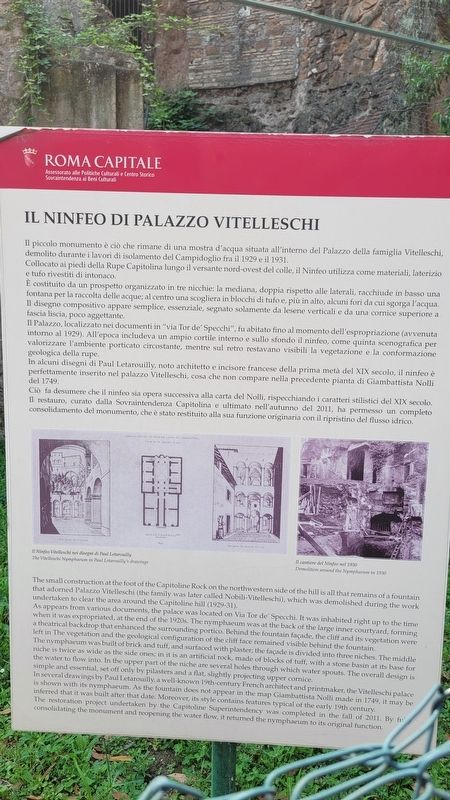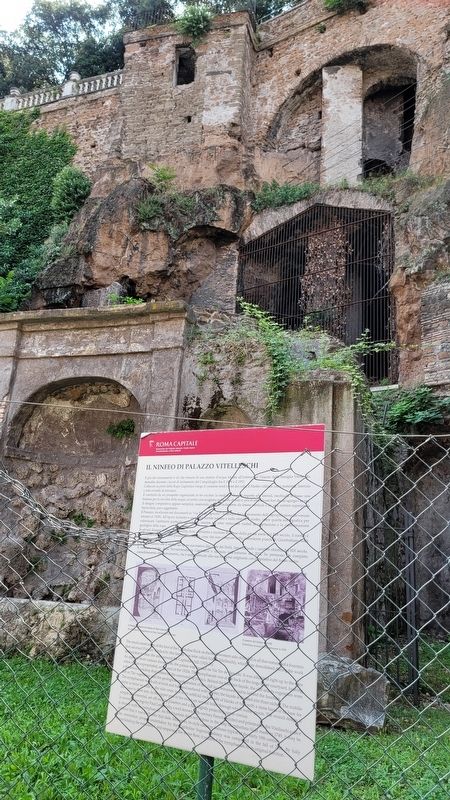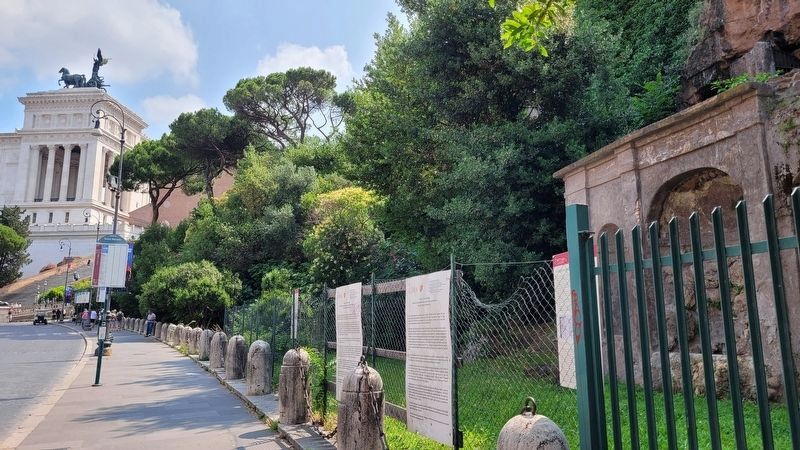Rione X Campitelli in Roma in Città metropolitana di Roma Capitale, Latium, Rome, Italy — Central Italy (Tyrrhenian Coast)
Il Ninfeo di Palazzo Vitelleschi / The Nymphaeum of Palazzo Vitelleschi
Inscription.
Collocato ai piedi della Rupe Capitolina lungo il versante nord-ovest del colle, il Ninfeo utilizza come materiali, laterizio e tufo rivestiti di intonaco.
È costituito da un prospetto organizzato in tre nicchie: la mediana, doppia rispetto alle laterali, racchiude in basso una fontana per la raccolta delle acque; al centro una scogliera in blocchi di tufo e, più in alto, alcuni fori da cui sgorga l'acqua. Il disegno compositivo appare semplice, essenziale, segnato solamente da lesene verticali e da una cornice superiore a fascia liscia, poco aggettante.
Il Palazzo, localizzato nei documenti in "via Tor de' Specchi", fu abitato fino al momento dell'espropriazione (avvenuta intorno al 1929). All'epoca includeva un ampio cortile interno e sullo sfondo il ninfeo, come quinta scenografica per valorizzare l'ambiente porticato circostante, mentre sul retro restavano visibili la vegetazione e la conformazione geologica della rupe.
In alcuni disegni di Paul Letarouilly, noto architetto e incisore francese della prima metà del XIX secolo, il ninfeo è perfettamente inserito nel palazzo Vitelleschi, cosa che non compare nella precedente pianta di Giambattista Nolli del 1749.
Ciò fa desumere che il ninfeo sia opera successiva alla carta del Nolli, rispecchiando i caratteri stilistici del XIX secolo. Il restauro, curato dalla Sovraintendenza Capitolina e ultimato nell'autunno del 2011, ha permesso un completo consolidamento del monumento, che è stato restituito alla sua funzione originaria con il ripristino del flusso idrico.
Didascalie
Sinistra: Il Ninfeo Vitelleschi nei disegni di Paul Letarouilly
Destro: Il cantiere del Ninfeo nel 1930
The small construction at the foot of the Capitoline Rock on the northwestern side of the hill is all that remains of a fountain that adorned Palazzo Vitelleschi (the family was later called Nobili-Vitelleschi), which was demolished during the work undertaken to clear the area around the Capitoline hill (1929-31).
As appears from various documents, the palace was located on Via Tor de' Specchi. It was inhabited right up to the time when it was expropriated, at the end of the 1920s. The nymphaeum was at the back of the large inner courtyard,
forming a theatrical backdrop that enhanced the surrounding portico. Behind the fountain façade, the cliff and its vegetation were left in. The vegetation and the geological configuration of the cliff face remained visible behind the fountain.
The nymphaeum was built of brick and tuff, and surfaced with plaster; the façade is divided into three niches. The middle niche is twice as wide as the side ones; in it is an artificial rock, made of blocks of tuff, with a stone basin at its base for the water to flow into. In the upper part of the niche are several holes through which water spouts. The overall design is simple and essential, set off only by pilasters and a flat, slightly projecting upper cornice.
In several drawings by Paul Letarouilly, a well-known 19th-century French architect and printmaker, the Vitelleschi palace is shown with its nymphaeum. As the fountain does not appear in the map Giambattista Nolli made in 1749, it may be inferred that it was built after that date. Moreover, its style contains features typical of the early 19th century.
The restoration project undertaken by the Capitoline Superintendency was completed in the fall of 2011. By fully consolidating the monument and reopening the water flow, it returned the nymphaeum to its original function.
Captions
Left: The Vitelleschi Nymphaeum
in Paul Letarouilly's drawings
Right: Demolition around the Nymphaeum in 1930
Erected by Roma Capitale Assessorato alle Politiche Culturali e Centro Storico Sovraintendenza ai Beni Culturali.
Topics. This historical marker is listed in these topic lists: Anthropology & Archaeology • Architecture. A significant historical year for this entry is 1929.
Location. 41° 53.579′ N, 12° 28.882′ E. Marker is in Roma, Lazio (Latium, Rome), in Città metropolitana di Roma Capitale. It is in Rione X Campitelli. Marker is on Via del Teatro di Marcello, 0.1 kilometers north of Via Montanara, on the right when traveling north. The marker is located along the east side of the sidewalk. Touch for map. Marker is at or near this postal address: Via del Teatro di Marcello 20, Roma, Lazio 00186, Italy. Touch for directions.
Other nearby markers. At least 8 other markers are within walking distance of this marker. La Rupe Capitolina Nel Versante Nord-Ovest / The Capitoline Rock on the North-West Side (a few steps from this marker); Area del teatro di Marcello / Area of the Theater of Marcellus (about 150 meters away, measured in a direct line); Insula dell'Ara Coeli (about 150 meters away); Teatro di Marcello / Marcellus Theater (about 150 meters away); Tempio di Apollo Sesiano Tempio di Bellona / Temple of Apollo Sesiano Temple of Bellona (about 150 meters away); Motivazione della medaglia d'oro concessa alla citta di roma nel 1949 (about 210 meters away); Portico Degli dei Consenti / Portico of the Harmonious Gods (about 210 meters away); Tempio di Vespasiano / Temple of Vespasian (about 210 meters away). Touch for a list and map of all markers in Roma.
Credits. This page was last revised on December 8, 2023. It was originally submitted on December 7, 2023, by James Hulse of Medina, Texas. This page has been viewed 56 times since then and 14 times this year. Photos: 1, 2, 3. submitted on December 8, 2023, by James Hulse of Medina, Texas.


